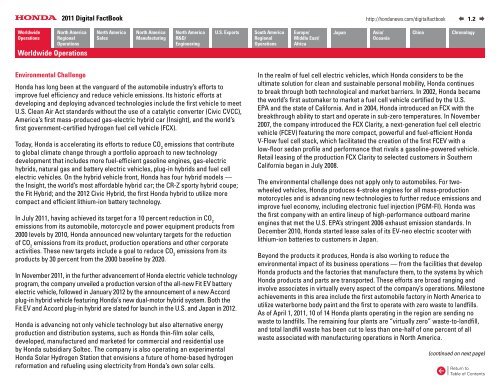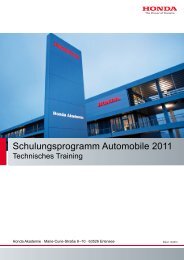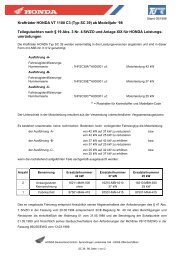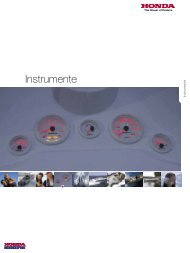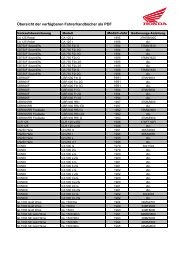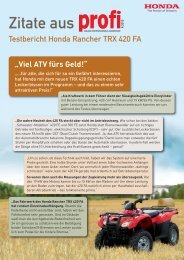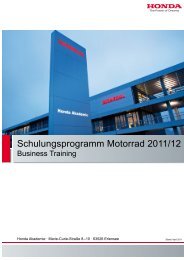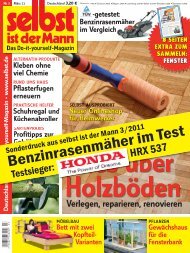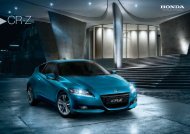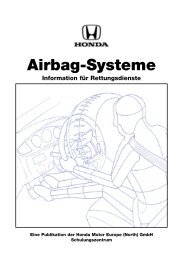2011 Digital Fact Book - Honda
2011 Digital Fact Book - Honda
2011 Digital Fact Book - Honda
- TAGS
- digital
- honda
- www.honda.com
You also want an ePaper? Increase the reach of your titles
YUMPU automatically turns print PDFs into web optimized ePapers that Google loves.
Worldwide Operations<br />
Environmental Challenge<br />
<strong>Honda</strong> has long been at the vanguard of the automobile industry’s efforts to<br />
improve fuel efficiency and reduce vehicle emissions. Its historic efforts at<br />
developing and deploying advanced technologies include the first vehicle to meet<br />
U.S. Clean Air Act standards without the use of a catalytic converter (Civic CVCC),<br />
America’s first mass-produced gas-electric hybrid car (Insight), and the world’s<br />
first government-certified hydrogen fuel cell vehicle (FCX).<br />
Today, <strong>Honda</strong> is accelerating its efforts to reduce CO 2 emissions that contribute<br />
to global climate change through a portfolio approach to new technology<br />
development that includes more fuel-efficient gasoline engines, gas-electric<br />
hybrids, natural gas and battery electric vehicles, plug-in hybrids and fuel cell<br />
electric vehicles. On the hybrid vehicle front, <strong>Honda</strong> has four hybrid models —<br />
the Insight, the world’s most affordable hybrid car; the CR-Z sporty hybrid coupe;<br />
the Fit Hybrid; and the 2012 Civic Hybrid, the first <strong>Honda</strong> hybrid to utilize more<br />
compact and efficient lithium-ion battery technology.<br />
In July <strong>2011</strong>, having achieved its target for a 10 percent reduction in CO 2<br />
emissions from its automobile, motorcycle and power equipment products from<br />
2000 levels by 2010, <strong>Honda</strong> announced new voluntary targets for the reduction<br />
of CO 2 emissions from its product, production operations and other corporate<br />
activities. These new targets include a goal to reduce CO 2 emissions from its<br />
products by 30 percent from the 2000 baseline by 2020.<br />
In November <strong>2011</strong>, in the further advancement of <strong>Honda</strong> electric vehicle technology<br />
program, the company unveiled a production version of the all-new Fit EV battery<br />
electric vehicle, followed in January 2012 by the announcement of a new Accord<br />
plug-in hybrid vehicle featuring <strong>Honda</strong>’s new dual-motor hybrid system. Both the<br />
Fit EV and Accord plug-in hybrid are slated for launch in the U.S. and Japan in 2012.<br />
<strong>Honda</strong> is advancing not only vehicle technology but also alternative energy<br />
production and distribution systems, such as <strong>Honda</strong> thin-film solar cells,<br />
developed, manufactured and marketed for commercial and residential use<br />
by <strong>Honda</strong> subsidiary Soltec. The company is also operating an experimental<br />
<strong>Honda</strong> Solar Hydrogen Station that envisions a future of home-based hydrogen<br />
reformation and refueling using electricity from <strong>Honda</strong>’s own solar cells.<br />
http://hondanews.com/digitalfactbook<br />
In the realm of fuel cell electric vehicles, which <strong>Honda</strong> considers to be the<br />
ultimate solution for clean and sustainable personal mobility, <strong>Honda</strong> continues<br />
to break through both technological and market barriers. In 2002, <strong>Honda</strong> became<br />
the world’s first automaker to market a fuel cell vehicle certified by the U.S.<br />
EPA and the state of California. And in 2004, <strong>Honda</strong> introduced an FCX with the<br />
breakthrough ability to start and operate in sub-zero temperatures. In November<br />
2007, the company introduced the FCX Clarity, a next-generation fuel cell electric<br />
vehicle (FCEV) featuring the more compact, powerful and fuel-efficient <strong>Honda</strong><br />
V-Flow fuel cell stack, which facilitated the creation of the first FCEV with a<br />
low-floor sedan profile and performance that rivals a gasoline-powered vehicle.<br />
Retail leasing of the production FCX Clarity to selected customers in Southern<br />
California began in July 2008.<br />
The environmental challenge does not apply only to automobiles. For twowheeled<br />
vehicles, <strong>Honda</strong> produces 4-stroke engines for all mass-production<br />
motorcycles and is advancing new technologies to further reduce emissions and<br />
improve fuel economy, including electronic fuel injection (PGM-FI). <strong>Honda</strong> was<br />
the first company with an entire lineup of high-performance outboard marine<br />
engines that met the U.S. EPA’s stringent 2006 exhaust emission standards. In<br />
December 2010, <strong>Honda</strong> started lease sales of its EV-neo electric scooter with<br />
lithium-ion batteries to customers in Japan.<br />
Beyond the products it produces, <strong>Honda</strong> is also working to reduce the<br />
environmental impact of its business operations — from the facilities that develop<br />
<strong>Honda</strong> products and the factories that manufacture them, to the systems by which<br />
<strong>Honda</strong> products and parts are transported. These efforts are broad ranging and<br />
involve associates in virtually every aspect of the company’s operations. Milestone<br />
achievements in this area include the first automobile factory in North America to<br />
utilize waterborne body paint and the first to operate with zero waste to landfills.<br />
As of April 1, <strong>2011</strong>, 10 of 14 <strong>Honda</strong> plants operating in the region are sending no<br />
waste to landfills. The remaining four plants are “virtually zero” waste-to-landfill,<br />
and total landfill waste has been cut to less than one-half of one percent of all<br />
waste associated with manufacturing operations in North America.<br />
1.2<br />
(continued on next page)


